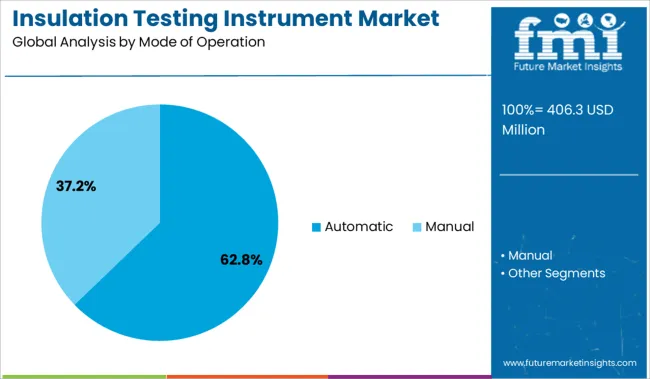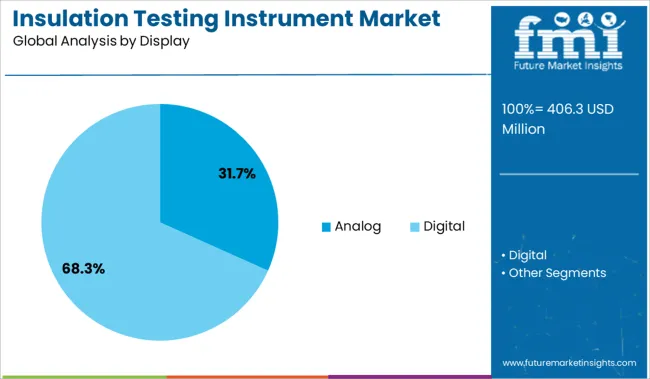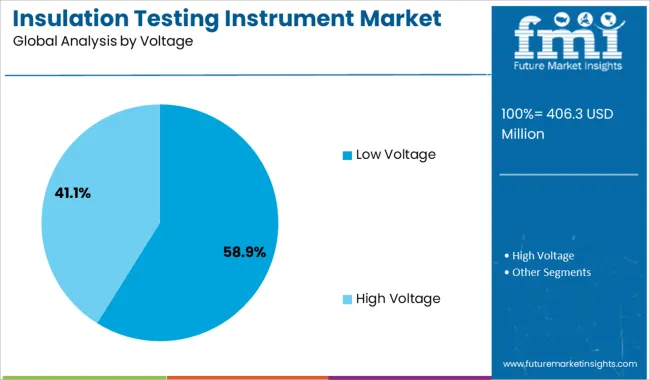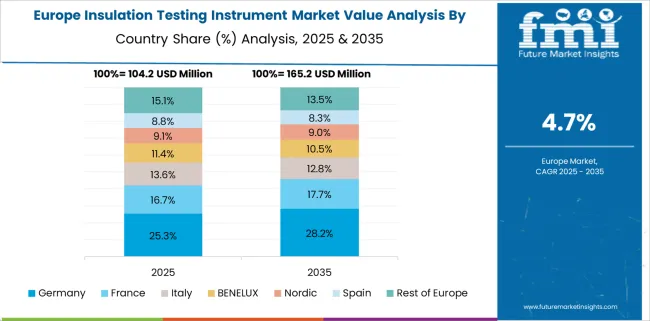The Insulation Testing Instrument Market is estimated to be valued at USD 406.3 million in 2025 and is projected to reach USD 668.2 million by 2035, registering a compound annual growth rate (CAGR) of 5.1% over the forecast period.

| Metric | Value |
|---|---|
| Insulation Testing Instrument Market Estimated Value in (2025 E) | USD 406.3 million |
| Insulation Testing Instrument Market Forecast Value in (2035 F) | USD 668.2 million |
| Forecast CAGR (2025 to 2035) | 5.1% |
The insulation testing instrument market is advancing steadily, driven by the increasing need for reliable electrical safety testing across various industries. The rise in infrastructure development, power generation, and industrial automation has necessitated comprehensive insulation monitoring to prevent electrical failures and hazards.
Improvements in testing technologies have made insulation instruments more user-friendly and accurate. Regulatory standards emphasizing electrical safety have further boosted the demand for testing instruments capable of verifying insulation integrity.
The growing emphasis on preventive maintenance and fault detection in electrical networks has contributed to the market's growth. The trend towards integrating smart and automated features is expected to enhance testing efficiency and data accuracy. Segment growth is projected to be led by automatic mode of operation due to its convenience, analog display for its simplicity and familiarity, and low voltage instruments because of their wide application in residential and commercial settings.
The market is segmented by Mode of Operation, Display, Voltage, and Current Type and region. By Mode of Operation, the market is divided into Automatic and Manual. In terms of Display, the market is classified into Analog and Digital. Based on Voltage, the market is segmented into Low Voltage and High Voltage. By Current Type, the market is divided into AC (Alternative Current) and DC (Direct Current). Regionally, the market is classified into North America, Latin America, Western Europe, Eastern Europe, Balkan & Baltic Countries, Russia & Belarus, Central Asia, East Asia, South Asia & Pacific, and the Middle East & Africa.

The automatic segment is forecasted to hold 62.8% of the insulation testing instrument market revenue in 2025, securing its position as the leading mode of operation. This segment’s expansion is attributed to the ease of use and reduced human error offered by automatic instruments.
Automatic testers simplify complex measurement processes by handling test sequence control and data logging, which appeals to both experienced technicians and less specialized users. The increasing need for rapid and reliable insulation testing in large electrical networks has accelerated the adoption of automatic instruments.
Additionally, automation supports enhanced safety by minimizing operator exposure to high voltages during testing. These factors combine to make the automatic segment a preferred choice in modern electrical maintenance and testing workflows.

The analog display segment is expected to contribute 31.7% of the market revenue in 2025, maintaining a significant share despite the rise of digital alternatives. Analog displays are valued for their simplicity, durability, and ease of reading under varied environmental conditions.
Field technicians often rely on analog instruments for quick visual assessments without the need for complex interfaces. The robustness of analog displays suits harsh industrial environments where reliability and quick interpretation are crucial.
Furthermore, analog instruments often come with lower price points making them accessible for smaller operations and educational purposes. While digital displays grow in popularity, the analog segment continues to serve a dedicated user base valuing straightforward and resilient instrumentation.

The low voltage segment is projected to hold 58.9% of the insulation testing instrument market revenue in 2025, reflecting its dominant application in residential, commercial, and light industrial electrical systems. Low voltage insulation testers are essential for verifying insulation quality in equipment such as household wiring, control panels, and lighting systems.
Their widespread use is driven by stringent safety regulations and the growing focus on preventive maintenance to avoid electrical faults. The compact size and portability of low voltage testers make them well-suited for on-site inspections and routine maintenance tasks.
Additionally, the expansion of electrification in emerging markets has increased demand for low voltage testing instruments to support infrastructure development. As awareness of electrical safety grows globally, the low voltage segment is expected to remain central to the insulation testing instrument market.
In recent years, emerging regions have seen an increase in the standards and regulations governing quality control and safety. Growing demand for electrical and electronic instruments is driving up demand for various testing instruments such as insulation testers, motor testers, and relay testers, among others.
Various industries, including manufacturing, power generation, and transportation, adhere to safety and quality control standards. Advancements in various industrial manufacturing sectors fuel the global insulation tester market's expansion. A focus on sustainable development is driving the demand for insulation testing instruments in various industries to ensure the integrity of the instrument and process.
The market is being driven by increased demand for industrial insulation tests due to their multipurpose applications. Because of the increased use of modern electrical instruments and machinery in industrial processes, the global use of insulation tests has increased.
Lack of awareness and low safety standards in emerging countries may act as a barrier to the growth of the insulation testing instrument market. Various regulations and standards for safety and quality management are followed in Europe and North America, whereas emerging countries such as India and China have comparatively less stringent regulations and standards. This is expected to have an impact on the insulation testing instrument market's potential growth.
The insulation testing instrument market was dominated by Asia Pacific. The leading share of Asia Pacific is attributed to Asian countries with large industrial bases, such as China, India, Korea, and Indonesia. The Asia Pacific insulation testing instrument market has a high growth potential; however, the lenient standards and regulations in Asian countries limit the insulation testing instrument market's potential growth to some extent.
Increased electrification and related projects in the region's emerging countries such as China, India, and Japan are expected to drive demand for industrial insulation testers. Furthermore, an increase in preventive maintenance regulations in various industries is expected to have a positive impact on the region's market.

According to Future Market Insights, because of an increase in the use of modern industrial insulation tests, as well as an increase in the installations of heavy electrical machinery or instrument in the areas' various industrial sectors, Europe is expected to hold significant market shares globally.
Europe is advantageous for expanding the insulation tester market due to increased electronic manufacturing and industrial building, as well as a well-established automotive industry. The continent is likely to provide a significant boost to economic activity, but prospects for long-term growth vary greatly across countries and sectors.

Some of the market participants identified across the value chain of the global insulation testing instrument market are:
| Report Attribute | Details |
|---|---|
| Growth Rate | CAGR of 5.1% from 2025 to 2035 |
| Base Year for Estimation | 2024 |
| Historical Data | 2020 to 2024 |
| Forecast Period | 2025 to 2035 |
| Quantitative Units | Revenue in USD Billion, Volume in Kilotons, and CAGR from 2025 to 2035 |
| Report Coverage | Revenue Forecast, Volume Forecast, Company Ranking, Competitive Landscape, Growth Factors, Trends, and Pricing Analysis |
| Segments Covered | Mode of operation, Display, Voltage, Current type, Region |
| Regions Covered | North America; Latin America; Europe; Asia Pacific; Middle East and Africa |
| Key Countries Profiled | USA, Canada, Brazil, Mexico, Argentina, Chile, Peru, Germany, United Kingdom, France, Spain, Italy, Russia, BENELUX, Australia & New Zealand, China, Japan, South Korea, GCC Countries, South Africa, Turkey |
| Key Companies Profiled | Megger; Fluke Corporation; Motwane; Jost's Engineering Company Limited; Meco Instruments Pvt. Ltd.; Transcat, Inc.; FLIR Systems; PCE Deutschland GmbH; MEGABRAS; Anaum International Electronics L.L.C; Cambridge Instruments & Engineering Co.; HIOKI E.E. CORPORATION; HV Diagnostics; SONEL S.A. |
| Customization | Available Upon Request |
The global insulation testing instrument market is estimated to be valued at USD 406.3 million in 2025.
The market size for the insulation testing instrument market is projected to reach USD 668.2 million by 2035.
The insulation testing instrument market is expected to grow at a 5.1% CAGR between 2025 and 2035.
The key product types in insulation testing instrument market are automatic and manual.
In terms of display, analog segment to command 31.7% share in the insulation testing instrument market in 2025.






Full Research Suite comprises of:
Market outlook & trends analysis
Interviews & case studies
Strategic recommendations
Vendor profiles & capabilities analysis
5-year forecasts
8 regions and 60+ country-level data splits
Market segment data splits
12 months of continuous data updates
DELIVERED AS:
PDF EXCEL ONLINE
Insulation Tester Market Size and Share Forecast Outlook 2025 to 2035
Insulation Films Market Size and Share Forecast Outlook 2025 to 2035
Insulation Paper Market Size and Share Forecast Outlook 2025 to 2035
Insulation Market Size and Share Forecast Outlook 2025 to 2035
Insulation Coatings Market Size and Share Forecast Outlook 2025 to 2035
Insulation Boards Market Size and Share Forecast Outlook 2025 to 2035
OEM Insulation Market Size and Share Forecast Outlook 2025 to 2035
Pipe Insulation Films Market Size and Share Forecast Outlook 2025 to 2035
Thin Insulation Market Size and Share Forecast Outlook 2025 to 2035
Pipe Insulation Market Size and Share Forecast Outlook 2025 to 2035
Cold Insulation Materials Market Size and Share Forecast Outlook 2025 to 2035
Cork Insulation Market Size and Share Forecast Outlook 2025 to 2035
Pipe Insulation Products Market Size and Share Forecast Outlook 2025 to 2035
Wool Insulation Market Size and Share Forecast Outlook 2025 to 2035
Cold Insulation Market Growth - Trends & Forecast 2025 to 2035
HVAC Insulation Market Trends & Forecast 2025 to 2035
Market Leaders & Share in the Pipe Insulation Products Industry
Tank Insulation Market Growth – Trends & Forecast 2024-2034
Foam Insulation Market Growth – Trends & Forecast 2024-2034
Wire Insulation & Jacketing Compounds Market

Thank you!
You will receive an email from our Business Development Manager. Please be sure to check your SPAM/JUNK folder too.
Chat With
MaRIA